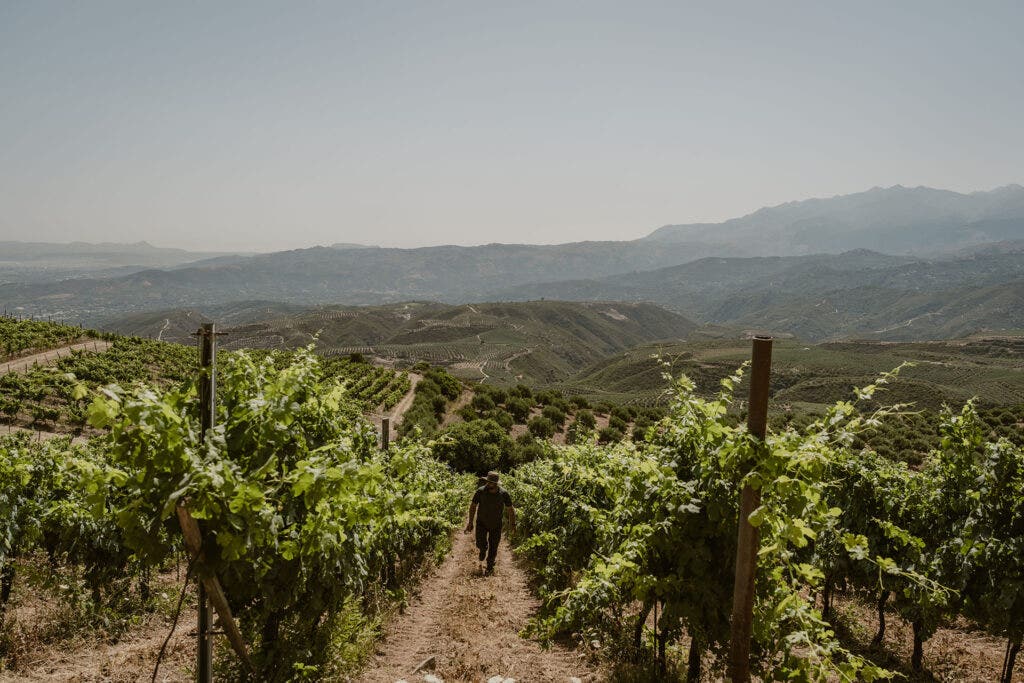In 2007, when Alexandra Manousakis left a corporate job in New York City to move to her family’s home in rural Crete, the wine scene on the Greek island was, in her words, “traditional.”
“There wasn’t a wine bar, you couldn’t find a stemmed glass,” she says. Many locals had only recently begun putting their bulk wine into bottles. Much of it was simply labeled “Vins de Crete,” and contained a blend of whatever red or white grapes had ripened in tandem in mixed plots.
Fast forward to 2023, and Manousakis is the second-generation owner of Manousakis Winery in Vatolakkos, Crete. It produces 150,000 bottles a year, including Syrah and Mourvedre that her father planted in 1993, as well as Cretan varieties like Vidiano, a white wine grape noted for its ageability, and Muscat de Spina, a local Muscat clone capable of Gewurztraminer-esque aromatics. The estate hosts tastings and events at its taverna, and partners with a tour operator to host trips throughout the region.
You May Also Like: A Wine Lover’s Guide to Santorini
The Manousakis family’s story plays on repeat across Crete. The island has a wine culture that spans millennia, but its modern industry just started to take shape in the last two decades. That’s when a series of cultural, demographic and economic changes radically altered the way Cretans make, drink and sell wine.
All of this means that right now is a pivotal time for anyone interested in buying or drinking Cretan wine. Unlike many European regions, the best and most age-worthy wines from Crete were made in the last 10 to 15 years, and often cost less than $25. The question isn’t whether wines from Crete will continue to improve with time—they already are. Instead, it’s if far-flung drinkers will embrace these relative newcomers far afield from the usual noble grapes and boldfaced domaines.

How We Got Here
As with any destination with a long history of human inhabitants, life on Crete has had its ups and downs. These include Bronze-age Minoan civilizations and periods under Roman, Byzantine, medieval Venetian and Ottoman rule. The latter era spanned 250 years and thwarted uprisings, until Crete won its independence in 1898.
In 1913, Crete became part of Greece. The largest island in a European country famous for picture-perfect beaches, Crete was home to many businesses initially focused more on tourism than wine. And so, as France began classifying its AOC vineyards in the 1950s, Cretan grape growers were perfectly happy producing bulk wine for sunburnt cruisers.
“A few large producers dominated wine production, focusing on high-volume, standard-quality wines to quench the thirst of tourists and later of the all-inclusive hotel guests,” says Eleni Kefalopoulou, a wine writer for Oinoxoos Magazine and Kathimerini newspaper in Athens. “In a way, this blocked the evolution of a modern wine industry.”

Things started to change in the final decades of the 20th century, thanks to innovators like Manolis and Sotiris Lyrarakis. In 1996, they released varietal wines made from Dafni and Plyto, two Cretan varieties that had previously been blended into Vins de Crete and might have otherwise gone extinct.
Another forward-thinking Cretan winemaker, Nikos Douloufakis, studied oenology in Alba, Italy, and then introduced local grapes Liatiko and Vidiano to his family winery in 1993.
“He makes exceptional wines,” says Kamal Kouiri, the general manager and wine director of Molyvos, a Manhattan restaurant with some 750 Greek wines in its cellar. “He understands how Cretan grape varieties grow, and knows how to make consumers love these wines.”
Yannis Economou was similarly ground-breaking. After studying in Alba and working in Germany and France, he planted indigenous and international varieties in a remote corner of eastern Crete in the mid-90s. Economou’s range includes blends of old-vine Liatiko and Mandilari, two local red wine grapes, and bottles are often released after being aged anywhere from 10 to 15 years. (Aged wines are priced accordingly, typically starting at $60.)
“Economou is a true wine artist,” says Kefalopoulou. “His way of thinking and producing wines reminds me of Eric Rodez in Champagne. He is a master blender and every wine of his is unique.”
You May Also Like: The Ancient Greek Varieties Making Thoroughly Modern Wines

Millennial Modernization
In the 21st century, a fleet of mostly millennial winemakers built on these advancements to further revolutionize Cretan wine. They studied oenology and viticulture everywhere from France and Italy to California, and then took the reins of family estates to modernize plots and processes in Crete’s diverse soils and microclimates.
Manousakis, who was born and raised in Washington, D.C., was among them. “Ten or 12 years ago, our generation was coming back and applying some very crucial winemaking techniques to wineries all over Crete,” she says. “That started this whole new wave of winemaking and experimentation.”
A trade organization, Wines of Crete, launched in 2006 and was similarly vital, Manousakis says. “That really created a bond and network for the wineries. It’s unheard of in Greece for competitors to come together and push for the greater good for everyone… All the wineries get along, for the most part.”
It certainly seems that way. When industry out-of-towners visit the island, Cretan winemakers co-host tastings at each other’s properties and tag-team varietal education. As international sommeliers and journalists take their first sips of Vidiano, young Cretan wine professionals share cigarettes and ask after each other’s families and harvests.
“I love what the new generation in Crete is doing,” says Kouiri. “They’re sitting at one table, and they’re thinking about Crete before they’re thinking about themselves.”
It’s a savvy approach. If two or three Bordeaux domains started exporting lackluster wine next year, it might hurt their sales but wouldn’t denigrate the reputation of the entire region. There are simply too many years of global goodwill toward Bordeaux for a few bad seeds to spoil the market. Crete, on the other hand, is a relative newcomer to the modern global wine industry. Few international buyers or collectors are familiar with varieties like Vidiano or Liatiko, and you only get one chance to make a first impression.

Aging Gracefully
Importantly, the wines are good. Sure, not all of the bottles from Crete are perfect—what region could make that claim?—but a baseline level of quality has been established and standouts are emerging.
“The wines are coming into their own,” says Kouiri. “Crete has an identity, which is one of the hardest things to do. Identity is three things: terroir, grape variety and winemaking. When you have an identity, then you’re able to compete worldwide.”
He’s especially enthusiastic about Cretan Vidiano. Gone are the days of masking its fresh stone fruit and savory white pepper flavors in heavy oak. Modern iterations from Lyrarakis, Douloufakis and Idaia are made in stainless steel, while others experiment with cement and amphora.
These wines age beautifully. With as little as two to four years of bottle age, “Vidiano develops this silky, rich texture… it becomes an even more serious wine,” he says.
Kefalopoulou remains impressed by Lyrarkis’s and Douloufakis’s wines, and notes how the Scalarea estate near the Cretan city of Heraklion works with Greece’s Boutari label to make “a top-ranking blend of Kotsifali and Syrah that can age for years.” She also champions Cretan Louliatiko, a dessert wine made from sun-dried Liatiko grapes, and Ampelourgein Winery’s high-altitude pét-nats.
All are thoroughly modern wines, but, like everything in Crete, they’re inseparable from centuries of history. It’s not always easy, having such deep-rooted heritage. But it’s never boring, either.
“That’s the beautiful thing about wine,” says Kouiri. “It’s a continuing art. It doesn’t end, it evolves.” And so does Crete.



